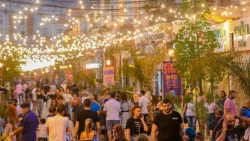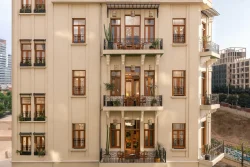Guides
5 Of Beirut’s Most Interesting Architectural Landmarks
Beirut is known for its rich history, housing buildings from eras dating back to before the Ottoman Empire and the French mandate, with each adding a layer of influence to our city. Let’s go back in time and revisit some of Beirut’s most impeccable architectural landmarks—some abandoned and others brought back to life as galleries and cultural centers—and read up on the stories behind them.
1. Le Grand Théâtre De Beyrouth
Also known as “Le Grand Théâtre des Mille et Une Nuits”, which translates to the Great Theater of One Thousand and One Nights. This magnificent space was designed by Youssef Aftimos and built in the 1920s by Jaques Tabet.
Since its opening in 1929, the Grand Théâtre hosted international performances and movie productions, where people admired the biggest stars of their time, such the Mohamed Abd El Wahab and Oum Kalthoum. Once home to a magical stage, endless rows of seats, and amazing sets, the theatre has been closed to the public since the end of the Lebanese civil war due to the damage sustained. A renovation project was considered at the end of the war by Solidere but it did not see the light.
From the fall of the Ottoman Empire to the current protests of the Lebanese people, this place carries with it almost a century of life.
2. Beit Beirut
Formerly a home for the Barakat family, this huge and striking yellow building occupies a prominent corner in Beirut on the former “green line” that separated East and West Beirut during the civil war.
During the war, it was turned into a place for snipers to take concealed positions and keep an eye on passersby. The building was saved from demolition, largely via the advocacy of local architect Mona Hallak. Under the ownership of the Beirut municipality, it has been renovated and officially reopened last year as an exhibition and urban cultural center. It currently houses a the Allo Beirut exhibition.
3. Al Omari Mosque
The Al-Omari Grand Mosque was originally the Church of Saint John and was built by the crusaders in the 12th century. It was converted into the city’s Grand Mosque by the Mamluks in 1291. One of the most significant religious sites in the city, the Al-Omari Grand Mosque is also one of the most ancient.
Badly damaged during the civil war, the mosque’s refurbishment was completed in 2004 to bring back the building’s origins and history. Beneath it, an ancient cistern with Roman columns and stone vaults has been preserved.
4. Tabbal Building – Beit Kanz
A not-so-famous building that has been part of Beirut for over a century. The Tabbal building, now more commonly known as Beit Kanz, is a cultural hub that celebrates Lebanon’s craftsmanship and culinary art. It held an exhibition after the August 4th, 2020 in memory of Gaïa Fodoulian, under the name of “Everyone is the Creator of One’s Own Faith.”
The historical and mesmerizing architecture will leave you speechless as soon as you step in and discover floor by floor, room by room, the story behind it. The Tabbal building was made a heritage site by the General Directorate of Antiquities back in 1999. It was one of the 800 protected buildings that sustained damage from the blast but has since been renovated.
5. The Egg
As you walk by the martyr’s square in Beirut, you cannot help but notice this weird structure dominating the skyline. It’s a pre-war movie theater that has come to be known as “The Egg”. It was officially part of the Beirut City Center complex (which was never finished) and boasts one of the most unusual designs within it.
The structure was built in 1965 by Lebanese architect Joseph Philippe Karam, part of a golden age of construction when modernist designers were commissioned to experiment with new ideas and materials across the city. The Egg became a monumental place for the October 17 revolution when protestors flooded into the building and reclaimed it with raves, film screenings, and debates. This building is perhaps the most memorable of Beirut’s architectural heritage.
What are some of your favorite landmarks in Beirut?
1. Le Grand Théâtre De Beyrouth
Also known as “Le Grand Théâtre des Mille et Une Nuits”, which translates to the Great Theater of One Thousand and One Nights. This magnificent space was designed by Youssef Aftimos and built in the 1920s by Jaques Tabet.
Since its opening in 1929, the Grand Théâtre hosted international performances and movie productions, where people admired the biggest stars of their time, such the Mohamed Abd El Wahab and Oum Kalthoum. Once home to a magical stage, endless rows of seats, and amazing sets, the theatre has been closed to the public since the end of the Lebanese civil war due to the damage sustained. A renovation project was considered at the end of the war by Solidere but it did not see the light.
From the fall of the Ottoman Empire to the current protests of the Lebanese people, this place carries with it almost a century of life.
2. Beit Beirut
Formerly a home for the Barakat family, this huge and striking yellow building occupies a prominent corner in Beirut on the former “green line” that separated East and West Beirut during the civil war.
During the war, it was turned into a place for snipers to take concealed positions and keep an eye on passersby. The building was saved from demolition, largely via the advocacy of local architect Mona Hallak. Under the ownership of the Beirut municipality, it has been renovated and officially reopened last year as an exhibition and urban cultural center. It currently houses a the Allo Beirut exhibition.
3. Al Omari Mosque
The Al-Omari Grand Mosque was originally the Church of Saint John and was built by the crusaders in the 12th century. It was converted into the city’s Grand Mosque by the Mamluks in 1291. One of the most significant religious sites in the city, the Al-Omari Grand Mosque is also one of the most ancient.
Badly damaged during the civil war, the mosque’s refurbishment was completed in 2004 to bring back the building’s origins and history. Beneath it, an ancient cistern with Roman columns and stone vaults has been preserved.
4. Tabbal Building – Beit Kanz
A not-so-famous building that has been part of Beirut for over a century. The Tabbal building, now more commonly known as Beit Kanz, is a cultural hub that celebrates Lebanon’s craftsmanship and culinary art. It held an exhibition after the August 4th, 2020 in memory of Gaïa Fodoulian, under the name of “Everyone is the Creator of One’s Own Faith.”
The historical and mesmerizing architecture will leave you speechless as soon as you step in and discover floor by floor, room by room, the story behind it. The Tabbal building was made a heritage site by the General Directorate of Antiquities back in 1999. It was one of the 800 protected buildings that sustained damage from the blast but has since been renovated.
5. The Egg
As you walk by the martyr’s square in Beirut, you cannot help but notice this weird structure dominating the skyline. It’s a pre-war movie theater that has come to be known as “The Egg”. It was officially part of the Beirut City Center complex (which was never finished) and boasts one of the most unusual designs within it.
The structure was built in 1965 by Lebanese architect Joseph Philippe Karam, part of a golden age of construction when modernist designers were commissioned to experiment with new ideas and materials across the city. The Egg became a monumental place for the October 17 revolution when protestors flooded into the building and reclaimed it with raves, film screenings, and debates. This building is perhaps the most memorable of Beirut’s architectural heritage.
What are some of your favorite landmarks in Beirut?





